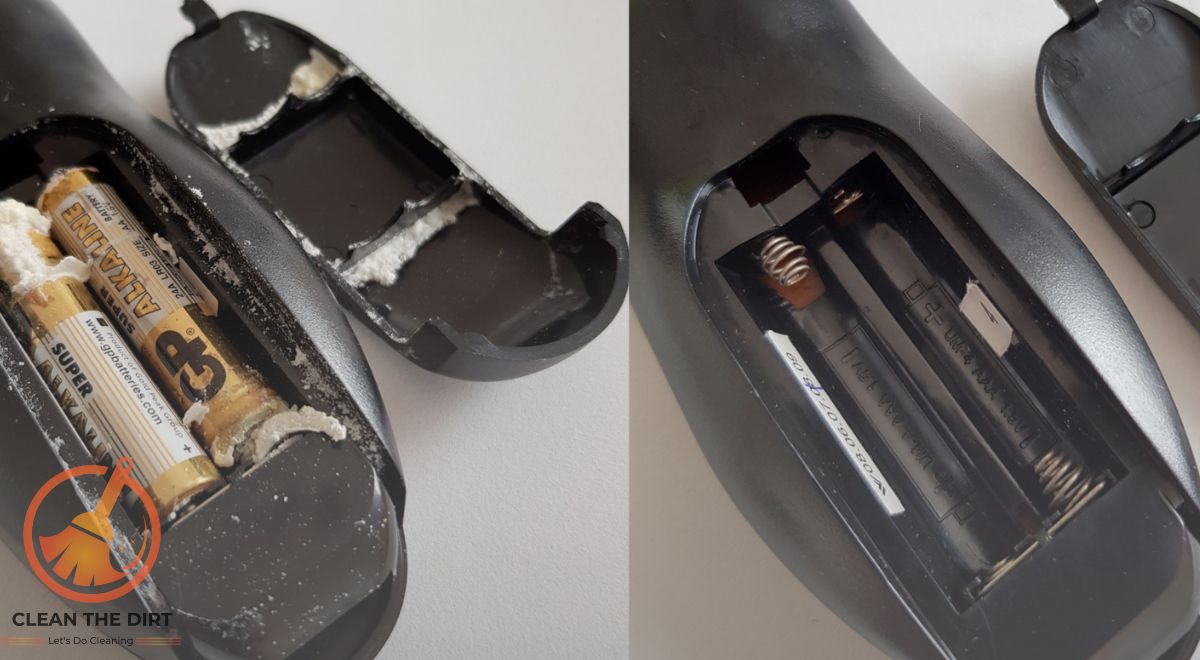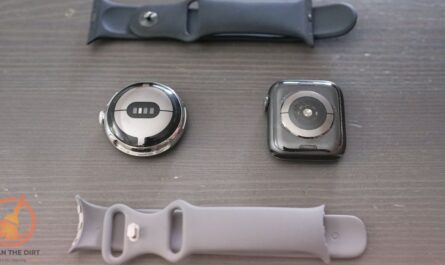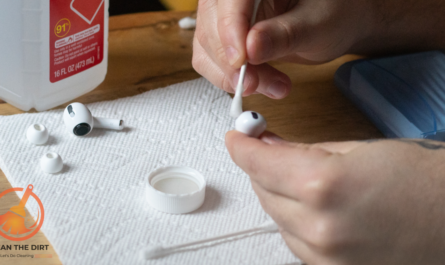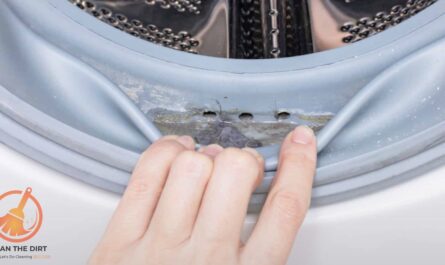Table of Contents
Introduction
Welcome to our comprehensive guide on how to clean battery acid from remote. If you’ve ever encountered a remote with sticky buttons or a rusty battery compartment, you’re not alone. Battery acid residue can accumulate over time, leading to malfunctions and reduced performance in your beloved devices.
In this guide on how to clean battery acid from remote, we’ll walk you through the steps to effectively clean battery acid residue from your remote, ensuring it continues to operate smoothly for many years. From identifying the signs of battery acid buildup to implementing safe and effective cleaning methods, we’ve got you covered.
Battery acid residue not only detracts from the attractiveness of your remote but can also pose a safety danger if left unchecked. That’s why it’s essential to address this issue promptly and with the right techniques. Whether you’re a DIY lover or a beginner in the realm of electronics maintenance, our guide is designed to be accessible and informative for all.
So, grab your remote, and let’s dive into the world of battery acid cleaning. By the end of this guide, you’ll have the knowledge and confidence to tackle this common issue and restore your remote to its former glory and you will be complete experts on how to clean battery acid from remote.
We will talk about and fully comprehend safety measures in the following section of our guide on how to clean battery acid from remote.
Safety Precautions
Cleaning battery acid from a remote control requires caution to ensure your safety and prevent further damage to the device. Follow these safety precautions before following the guide on how to clean battery acid from remote effectively.
1. Protective Gear
Before starting the cleaning process, ensure you’re wearing appropriate protective gear, including gloves and safety goggles, to shield your skin and eyes from exposure to battery acid.
2. Ventilation
Work in a well-ventilated area to minimize exposure to fumes emitted by battery acid. Open windows or use a fan to ensure proper airflow during the cleaning process.
3. Power Off the Remote
Always disconnect the power source from the remote control before acting on the guide on how to clean battery acid from remote controls. Remove the batteries and ensure the remote is powered off to prevent electrical hazards.
4. Avoid Direct Contact
Handle the remote and any components infected with battery acid residue with care. Avoid direct skin contact with the residue to prevent skin irritation or chemical burns.
5. Use Neutralizing Agents
If available, use neutralizing agents such as baking soda or a commercial battery acid neutralizer to neutralize any remaining battery acid residue before cleaning. This helps minimize the risk of further corrosion.
6. Dispose of Contaminated Materials Properly
Dispose of used cleaning materials, such as paper towels or cotton swabs, properly after cleaning battery acid residue. Seal them in a plastic bag and dispose of them according to local regulations for hazardous waste.
7. Seek Professional Assistance if Necessary
If you’re unsure about safely cleaning battery acid residue from your remote or if the damage is extensive, consider seeking professional assistance from a qualified technician or repair service.
By following these safety precautions, you can clean battery acid residue from your remote control safely and effectively, restoring its functionality and prolonging its lifespan. It is essential to remember that you should clean and care for your other household items regularly. For example, you should pay attention to cleaning your headphone pads for better sound quality and you should clean battery corrosion from toys to increase their lifespan.
Stay tuned for the next section, where we’ll discuss step-by-step instructions on how to clean battery acid from remote.
Step-by-Step Cleaning Guide: How to Clean Battery Acid from Remote?
1. Gather Supplies
Before you begin, gather the necessary supplies, including protective gloves, safety goggles, cotton swabs, mild dish soap, baking soda, water, and a soft cloth.
2. Safety First
Put on protective gloves and safety goggles to protect your skin and eyes from exposure to battery acid. Choose a well-ventilated workspace to reduce the amount of fumes you inhale.
3. Inspect the Remote
Carefully inspect the remote control for signs of battery acid leakage or corrosion. Pay attention to the battery compartment and terminals.
4. Create a Neutralizing Solution
Mix a small quantity of baking soda with water to create a paste. Baking soda helps neutralize the acidity of the battery acid.
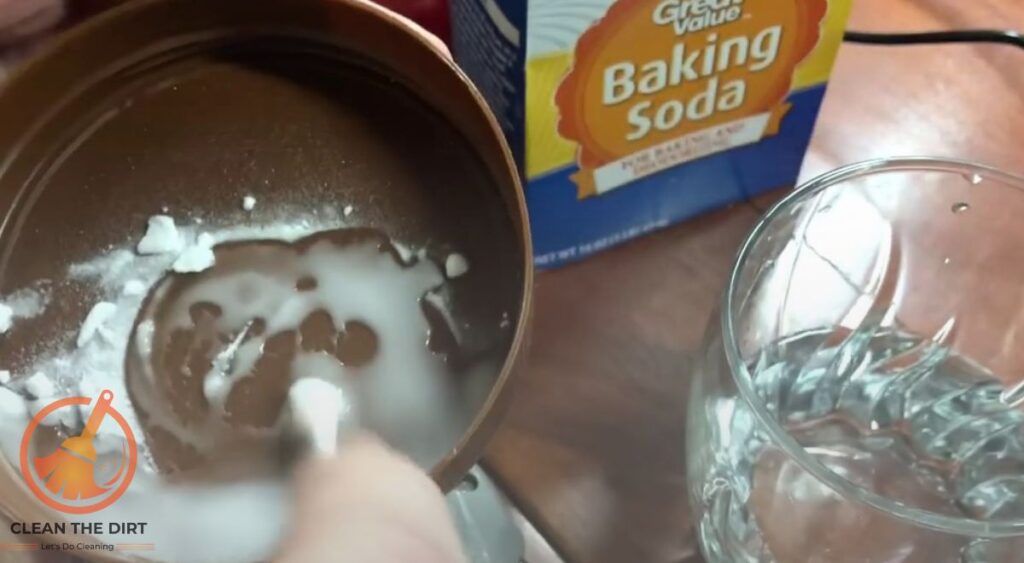
5. Apply the Neutralizing Solution
Using a cotton swab or soft cloth, apply the baking soda paste to the affected areas of the remote control. Gently rub the paste onto the corroded spots to neutralize the acid.
6. Clean with Soap and Water
Wet a clean cloth with a water-and-light-dish soap solution. Carefully wipe down the entire surface of the remote control, focusing on the areas with battery acid residue.
7. Rinse and Dry
Wash the remote control with clean water to remove any soap residue. Dry the remote thoroughly with a soft cloth or towel. Make sure there is no moisture left inside the battery compartment.
8. Inspect and Test
After cleaning, inspect the remote control for any remaining residue or damage. Reinsert the batteries and test the functionality of the remote to ensure it’s working properly.
10. Monitor for Signs of Corrosion
Keep an eye on the remote control in the following days and weeks for any signs of recurring corrosion or leakage. If you notice any issues, repeat the cleaning process or seek professional assistance.

By following these step-by-step instructions on how to clean battery acid from remote, you can effectively clean battery acid residue from your remote, refreshing its functionality and extending its lifespan.
Understanding Battery Acid Residue
Before learning how to clean battery acid from remote you should know what is battery acid or its residue. Battery acid residue, also known as battery leakage or corrosion, is a common issue that can affect the functionality of electronic devices, including remote controls. It occurs when the chemicals inside batteries, typically alkaline or acidic solutions, leak out and react with the surrounding components.
Signs of Battery Acid Residue
1. Visual Indications
One of the most apparent signs of battery acid residue is visible corrosion on the battery terminals or inside the battery compartment of your remote.
2. Sticky Buttons
You may notice that the buttons on your remote feel sticky or lagging to press. This stickiness is often caused by residue from leaked battery acid.
3. Reduced Performance
Battery acid residue can cause corrosion in remote controls that exhibit erratic or irregular behavior, such as not responding to button inputs or turning on and off without warning.
Effects of Battery Acid Residue
Battery acid residue can have several damaging effects on your remote controls.
1. Electrical Interference
The corrosive nature of battery acid residue can interfere with the electrical connections inside your remote, leading to damaging the circuits and reduced performance.
2. Component Damage
Prolonged exposure to battery acid residue can cause irreversible damage to the internal components of your remote, potentially rendering it unusable.
3. Safety Concerns
In addition to affecting the functionality of your remote, battery acid residue can pose a safety hazard, especially if it comes into contact with your skin or eyes.
Importance of Cleaning Battery Acid Residue
It’s essential to handle battery acid residue promptly to prevent further damage to your remote and ensure its continued functionality. Failure to clean the residue can result in permanent damage to the device, requiring costly repairs or replacement.
Alternative Methods for Cleaning Battery Acid from Remote
While traditional methods like using baking soda and mild dish soap are effective for cleaning battery acid residue from a remote control, there are alternative methods you can try. Here are some alternative strategies to think about.
1. Vinegar Solution
Vinegar is known for its acidic properties, which can help break down battery acid residue. To make a solution, combine equal amounts of white vinegar and water. Dip a cotton swab or soft cloth into the vinegar solution and gently rub it onto the affected areas of the remote control. Follow up with a clean damp cloth to remove any residue.
2. Rubbing Alcohol
Rubbing alcohol, also known as isopropyl alcohol, can help dissolve battery acid residue and evaporate quickly, leaving no residue behind. Wet a cotton swab or soft cloth with rubbing alcohol and gently wipe the affected areas of the remote control. Be sure to test a small, unnoticeable area first to ensure compatibility with the remote’s materials.
3. Commercial Cleaners
There are various commercial cleaners available specifically designed for removing battery acid residue and corrosion. These cleaners often come in spray or liquid form and contain ingredients that effectively dissolve and neutralize acid formation. Follow the manufacturer’s instructions carefully when using commercial cleaners, and be sure to wear protective gloves and work in a well-ventilated area.
4. Citric Acid Solution
Citric acid, found in citrus fruits like lemons and oranges, can also help break down battery acid residue. Dissolve a small amount of citric acid powder in water to create a solution. Apply the solution to the affected areas of the remote control using a cotton swab or soft cloth, then wash thoroughly with clean water and dry the remote completely.
5. Electronics Cleaning Wipes
Electronics cleaning wipes are pre-moistened wipes specifically formulated for cleaning electronic devices, including remote controls. These wipes are convenient and easy to use, making them a convenient option for quick cleaning tasks. Simply wipe the affected areas of the remote control with the cleaning wipe, following the manufacturer’s instructions.

6. Dry-Erase Marker
In some cases, a dry-erase marker can help remove stubborn battery acid residue from plastic surfaces. Color over the affected areas of the remote control with the dry-erase marker, then wipe away the marker ink and residue with a soft cloth. This method may require multiple applications for optimal results.
When trying alternative methods of the guide on how to clean battery acid from remote, always proceed with caution and test a small, hidden area first to ensure compatibility with the remote’s materials. If you’re unsure about which method to use or if the damage is extensive, consider seeking professional assistance.
Preventive Measures
By taking preventive measures, you may keep your remote control from being damaged by battery acid and increase its lifespan. Here are a few safety tips to save your remote.
1. Check Batteries Regularly:
Regularly check your remote control’s batteries for corrosion or leaks. To avoid harming the internal components of the remote control, replace outdated or corroded batteries right away.
2. Use High-Quality Batteries
Invest in high-quality batteries for your remote control to minimize the risk of leakage and corrosion. Pick reputable brands and avoid using expired or cheap batteries, which can leak more easily.
3. Store Remotes Properly
Keep your remote controls out of direct sunlight and extremely hot or cold conditions by keeping them in a cool, dry place. Avoid storing them near moisture-prone areas like bathrooms or kitchens, as humidity can contribute to battery corrosion.
4. Remove Batteries When Not in Use
If you won’t be using your remote control for an extended period, such as during vacations or when using a universal remote, remove the batteries from the remote to prevent potential leakage and corrosion.
5. Clean Spills Immediately
If your remote control comes into contact with any liquid, such as spilled drinks or cleaning solutions, clean it immediately with a dry cloth. To stop moisture from leaking into the battery compartment, don’t use the remote until it is totally dry.
6. Inspect Remote Regularly
Periodically inspect your remote control for any signs of battery acid residue, corrosion, or damage. Address any issues promptly to prevent further deterioration and potential malfunction of the remote.
7. Educate Family Members
Educate your family members, especially children, about the importance of proper handling and care of remote controls. Encourage them to use remotes responsibly and avoid mishandling or dropping them.
8. Use Protective Covers
Consider using protective covers or cases for your remote controls to shield them from accidental spills or drops. Silicone or plastic covers can provide an extra layer of protection against damage.
9. Regular Maintenance
Perform regular maintenance on your remote controls by cleaning them with a dry cloth to remove dust and debris. Avoid using harsh chemicals or abrasive cleaners, as they can damage the remote’s surface.
10. Seek Professional Assistance
If you notice any signs of battery acid damage or corrosion on your remote control, seek professional assistance from a qualified technician. Attempting to repair extensive damage yourself may cause further harm to the remote.
By following preventive measures and steps how to clean battery acid from remote, you can help protect your remote controls from battery acid damage and ensure they remain in good working condition for longer periods.
Conclusion
Cleaning battery acid from remote controls is a task that requires caution, patience, and the right techniques to ensure the safety of both the device and the individual handling it. By following the steps outlined in this guide on how to clean battery acid from remote controls, you can effectively remove battery acid residue and prevent further damage to your valuable electronic devices.
Throughout this article, we’ve discussed various methods for safely cleaning battery acid from remote controls, including using household items like baking soda, vinegar, and rubbing alcohol, as well as preventive measures to avoid battery acid damage in the first place.
Remember, safety should always be your top priority when dealing with battery acid residue. Wear protective gear, such as gloves and safety goggles, and work in a well-ventilated area to minimize exposure to harmful chemicals. Additionally, always test your remote control after cleaning to ensure that it’s functioning properly.
Let’s take a look at a comparison table of cleaning methods suitable for you.
| Cleaning Method | Effectiveness | Safety | Accessibility | Cost |
|---|---|---|---|---|
| Baking Soda | High | Safe | Easily available | Low |
| Vinegar Solution | Moderate | Safe | Common household item | Low |
| Rubbing Alcohol | High | Moderate | Widely available | Moderate |
| Lemon Juice | Moderate | Safe | Common household item | Low |
By incorporating these cleaning techniques of this guide on how to clean battery acid from remote and preventive measures into your routine maintenance, you can prolong the life of your remote controls and keep them in optimal working condition for years to come. If you encounter extensive damage or are unsure about how to proceed, don’t hesitate to seek professional assistance from a qualified technician.
Remember that other household products and gadgets must also be cleaned regularly and given proper care. For example, clean the battery acid from remote controls to ensure the toys’ perfect condition and clean the Apple watch band to enhance the watch’s fresh look.
We appreciate your interest in our article on how to clean battery acid from remote. We hope you found the information helpful and that you can apply these tips to safely and effectively clean your remote controls.
Remember, a little care goes a long way in preserving the functionality and longevity of your electronic devices.
Frequently Asked Questions (FAQs) for How to Clean Battery Acid from Remote Controls?
Can I use water to clean battery acid from my remote control?
No, water should not be used to clean battery acid from a remote control as it can cause further damage to the electronic components. Instead, use mild cleaning solutions like baking soda or vinegar.
What should I do if I notice battery acid leakage in my remote control?
If you notice battery acid leakage in your remote control, immediately remove the batteries and dispose of them properly. Clean the affected areas with a dry cloth or cotton swab and follow the recommended cleaning steps outlined in our guide.
Is it safe to touch battery acid residue with bare hands?
No, it’s not safe to touch battery acid residue with bare hands as it can cause skin irritation or burns. Always wear protective gloves when handling battery acid residue to minimize the risk of exposure.
Can I use rubbing alcohol to clean battery acid from my remote control?
Yes, rubbing alcohol can be used to clean battery acid residue from remote controls. However, it’s important to use it sparingly and avoid excessive moisture, as it can damage the internal components of the remote.
How often should I clean my remote control to prevent battery acid damage?
It’s recommended to clean your remote control regularly, especially if you notice any signs of battery acid leakage or corrosion. Incorporate routine maintenance into your cleaning routine to prevent battery acid damage.
What should I do if my remote control stops working after cleaning the battery acid residue?
If your remote control stops working after cleaning battery acid residue, it may indicate underlying damage to the internal components. In such cases, it’s best to seek professional assistance from a qualified technician for repair or replacement.
Can I prevent battery acid leakage in my remote control?
While it’s not always possible to prevent battery acid leakage entirely, you can take preventive measures such as using high-quality batteries, storing remotes properly, and regularly inspecting for signs of leakage to minimize the risk.
Are there any home remedies for cleaning battery acid from remote controls?
Yes, several home remedies such as baking soda, vinegar, or lemon juice can be effective in cleaning battery acid residue from remote controls. However, always use caution and follow proper cleaning techniques to avoid further damage.
You May Also Like: How to Clean Airpod Microphone? A Step-by-Step Guide for Crystal Clear Sound

